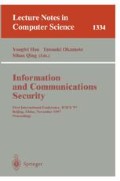Abstract
This paper provides a comparative assessment of detection in certain voice hiding techniques. The assessment is based on the complexity of breaking the stego key, the robustness of the hiding techniques, and the stego transmission rate. Unlike cryptography, to break the stego key in voice communication requires not only an extensive search but also estimation techniques for determining the values of parameters used in data embedding. We also consider disturbing embedded data in case resource constraints are imposed.
Research supported by the Office of Naval Research.
Preview
Unable to display preview. Download preview PDF.
References
Anderson, R. (1996) “Stretching the Limits of Steganography”. In Proceedings of Information Hiding Workshop, University of Cambridge, pp. 39–48.
Bender, W., Gruhl, D., Morimoto, N. & Lu, A. (1996) “Techniques for data hiding”. IBM Systems Journal, Vol 35, NOS 3&4, pp. 313–336.
Bogert, B., Healy, M. & Tukey, J. (1963) “The Quefrency Analysis of Time Series for Echoes”. Proc. Symp. on Time Series Analysis, (ed. Rosenblatt, M.), pp. 209–243, Wiley
Chang, L. (1997) “Analysis of Hiding Data in Speech Signal”. in preparation.
Cox, I., Kilian, J., Leighton, T. & Shamoon, T. (1995) “Secure Spread Spectrum Watermarking for Multimedia”. NEC Research Institute, TR 95-10.
Dixon, R. (1994) Spread Spectrum Systems with Commercial Applications. John Wiley & Sons.
Gruhl, D., Lu, A. & Bender, W. (1996) “Echo Hiding”. In Proceedings of Information Hiding Workshop, University of Cambridge, pp. 295–315.
Hall, D (1972) Journal of the Acoustical Society, 1972 Vol 51, pp. 1863–1871 & 1872–1881.
Flanagan, D. (1972) Speech Analysis. Springer-Verlag.
Kang, G. (1985) “Narrowband Integrated Voice Data System Based on the 2400b/s LPC”. NRL TR 8942.
Meadows, C. and Moskowitz, 1. (1996) “Covert Channels—A Context Based View”. In Proceedings of Information Hiding Workshop, University of Cambridge, pp. 73–94.
Pierce, H. (1995) The Science of Musical Sound. Freeman.
Pfitzmann, B. (1996) “Information Hiding Terminology”. In Proceedings of Information Hiding Workshop, University of Cambridge, pp. 347–350.
Proakis, J. (1996) Digital Communication. McGraw-Hill.
Schneier, B. (1996) Applied Cryptography. Wiley.
Author information
Authors and Affiliations
Editor information
Rights and permissions
Copyright information
© 1997 Springer-Verlag
About this paper
Cite this paper
Chang, L., Moskowitz, I.S. (1997). Critical analysis of security in voice hiding techniques. In: Han, Y., Okamoto, T., Qing, S. (eds) Information and Communications Security. ICICS 1997. Lecture Notes in Computer Science, vol 1334. Springer, Berlin, Heidelberg. https://doi.org/10.1007/BFb0028476
Download citation
DOI: https://doi.org/10.1007/BFb0028476
Published:
Publisher Name: Springer, Berlin, Heidelberg
Print ISBN: 978-3-540-63696-0
Online ISBN: 978-3-540-69628-5
eBook Packages: Springer Book Archive

